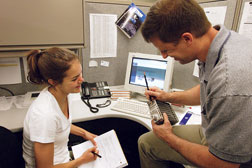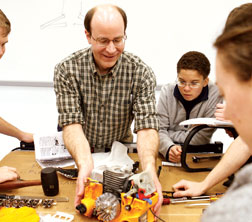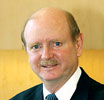 Photo:Olin College Senior Robin Maslowski takes in new skills at summer internship.
|
Olin College, a nontraditional engineering school located in a very traditional bastion of higher education, doesn’t do what might be expected. The Needham, Mass., college is in the heart of the upscale eastern Ivy League but appeals to middle class students with free tuition and claims that it is not elitist. Its now-deceased benefactor and its current president both have ties to civil engineering, but there is no such major there. And, the school pushes entrepreneurship and competitiveness to students, yet has few links to an industry founded on those principles.
Even so, Olin is making waves in academic and corporate worlds with its innovative approach, and it is tapping into new thinking by students, even with skeptical parents.
|
Olin’s teaching philosophy eschews traditional academic boundaries and embraces creativity, communication, passion and teamwork. “In traditional education, you basically sat in class and were given discreet sets of information with no fusion,” says David Barrett, an Olin mechanical engineering professor trained at the University of Massachusetts and MIT. “At Olin, we build something and then we build it again. We’re not better, just different.”
Different is perhaps an understatement. Olin has only 300 undergraduates and was founded in the late 1990s with about $450 million from the F.W. Olin Foundation. It was named for Franklin W. Olin, who founded a construction business in the 1890s, followed by ammunition and chemical firms that became Olin Corp., today a $2.4-billion empire.
The foundation, which used to fund technical facilities at U.S. universities, opted instead to invest its cash in a new school with its own approach to teaching engineering, says Richard K. Miller, hired in 1999 as Olin College president. He was recruited from the University of Iowa, where he did earthquake engineering research and was engineering dean. While there, Miller created what is billed as the nation’s first “technological entrepreneurship” certificate program because “students didn’t know what a patent was and the university’s business school didn’t know how to enroll engineers,” he says.
Such problems don’t exist at Olin because it has strong ties with neighboring Babson College, which has a strong business entrepreneurial focus recognized by U.S. News and World Report and others. Students from nearby Wellesley College, which has mostly women and no engineering school, also take classes at Olin.
Olin offers only three engineering degrees: mechanical, electrical-computer and a broad-based major with concentrations in bioengineering, computing or materials science. Miller says there are no current plans to add civil, which would require more instructors and change the student-staff ratio. The school has about 40 educators on its faculty. There are no academic departments and no tenure. “Many of us walked away from lifetime employment,” says Miller, who insists that faculty salaries are “compatible” with industry norms. Barrett left tech firm iRobot for Olin, “because I wanted give something back,” he says. He is an alumnus of Walt Disney Imagineering.
Despite Olin’s appeal to the middle class, the school is quite selective. The 89-person freshman class, the school’s largest to date, has an average SAT score of 2200, a 4.3 weighted GPA and includes 64 Advanced Placement scholars and 34 National Merit finalists. Still, Miller insists “we don’t select for test scores.” He says Olin’s student body is 50% women and 30% “people of color,” unusual for engineering. Its faculty is 40% female as well.
Potential students attend a “candidates’ weekend,” where they and Olin see if there’s a match. Prospects participate in team projects. “They find out what makes you tick and what you’re passionate about. It’s not just your SAT scores,” says junior Tiana Veldwisch, a bioengineering major who had full scholarships to other top schools and is involved in a local theatre and chorus. “I fell in love with the atmosphere, how collaborative it was,” she says. “If you hate working in groups, it would be miserable here.”
Miller says Olin’s curriculum still depends on “rigorous” math and science, but entrepreneurial thinking, creativity and innovation are equally critical. Focus on design is also key. “Students have a design project every semester,” he says. “In traditional programs, there was not enough design soon enough, so they bailed out.” Freshmen use CAD on laptops to design “things that go, or something that mimics the way an animal works,” says Miller. Sophomores “come up with products that don’t exist, interviewing clients with a need,” he adds. “Clients” included operating room nurses and bicycle messengers, Miller says.
Olin is among U.S. schools included on Business Week’s recently published first-ever list of top design programs. Named schools “emphasize multidisciplinary approaches, combining engineering, business and social sciences,” says Olin’s Website. Communication also is paramount. “I’m not concerned to give a 10-minute Powerpoint presentation,” says Veldwisch. “From the very beginning, they train us to deliver information.”
 Photo:Olin College Olin College mechanical engineering professor David Barrett interacts with students.
|
Olin’s innovative approach has attracted corporate interest, as employers seek the next competitive edge. “One validation of this curriculum is when companies actively want to work with us,” says Barrett. The school has a strong internship program and had to turn away firms from SCOPE, in which teams of seniors “work as consultants to corporate sponsors, who provide funding and a challenging engineering problem,” he adds. Last year, 13 companies committed $50,000 each to SCOPE, says Miller.
 Miller
|
With Olin’s first 66 graduates last year, it now seeks acceptance. “We needed a product,” says Miller. Half went on for more education and half are working. He ticks off numbers hired by big corporations or accepted into prestigious programs and grad schools, but notes proudly that 10% started their own businesses. This month, Olin hosted the Accreditation Board for Engineering and Technology (ABET), for the first time.
But Gregs Thomopoulos, CEO of Muscatine, Iowa-based Stanley Consultants and a friend of Miller’s from the state university, laments that Olin graduates are not being better groomed for consulting engineering careers. He is the only construction industry executive on the school’s President’s Council.
Some observers also question whether Olin’s approach can be copied elsewhere in academia, especially at large schools that don’t have its resources. “Our mission is not to create an academic model for all colleges,” says Barrett. “But a lot of schools are doing similar things.” James Ernzen, new director of the Del E. Webb School of Construction at Arizona State University, envisions more interdisciplinary education there. “But it won’t happen overnight,” he says, noting ASU’s size and financial constraints. “We have to compete with other disciplines that are sexier.”
 Related Links:
Related Links: 
Post a comment to this article
Report Abusive Comment